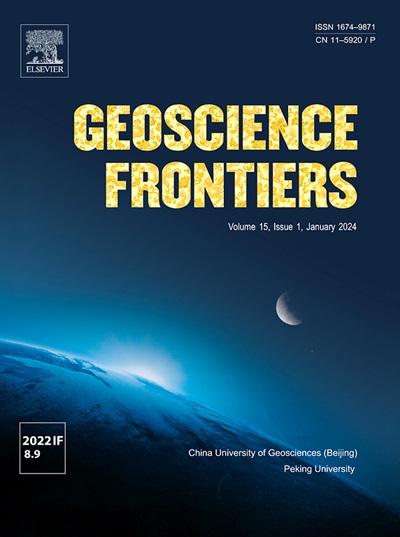Consistent crystal orientation of core and rim pyrites indicates an epitaxial growth of rim in Carlin-type gold deposits
IF 8.5
1区 地球科学
Q1 GEOSCIENCES, MULTIDISCIPLINARY
引用次数: 0
Abstract
The gold-bearing arsenian pyrite in Carlin-type gold deposits typically grows around the gold/arsenic-poor pyrite core, forming core–rim textured pyrite. However, the causes of rim pyrite precipitation around the early-formed core pyrite and the growth mechanisms of the rim pyrite remain unclear. Here, we combined scanning electron microscopy, electron probe micro-analysis, and nanoscale secondary ion mass spectrometry to investigate the textural and chemical characteristics of core–rim textured pyrite from the giant Shuiyindong and Lannigou gold deposits. Furthermore, we used electron backscattered diffraction and transmission electron microscopy to characterize their crystallographic structure. The results indicated that core–rim textured pyrite is the dominant pyrite type in the ore. This type of pyrite is characterized by the sharp core–rim interfaces, euhedral-subhedral morphology, and oscillating zoning. The gold/arsenic-rich rim and gold/arsenic-poor core formed during the main-ore and pre-ore stages, respectively. Crystallographically, the rim showed that a crystallographic orientation is similar to that of the core along the (0 1 0) crystal facet, indicating that the core pyrite serves as a template for the epitaxial growth of rim pyrite. Textural and chemical features indicate that the epitaxy occurs in the process of direct precipitation of main-ore pyrite over the pre-ore pyrite. As Carlin ore fluids dissolve the iron-bearing carbonates, iron concentrations in the fluids increase, thereby creating a supersaturation environment suitable for the nucleation of main-ore pyrite. Because the minimal lattice misfit would minimize the surface free energy and the (0 1 0) facet of pyrite has a lower surface energy than other facets, the nucleated pyrite would readily grow along the (0 1 0) facet of preexisting pyrite via epitaxy. Our findings highlight that the widespread preexisting pyrite facilitates late-stage pyrite precipitation. For Carlin-type gold deposits, the pre-ore pyrite is essential owing to its promoting the precipitation of gold-bearing pyrite.

卡林型金矿岩心与边缘黄铁矿晶体取向一致,表明边缘呈外延生长
卡林型金矿床含金砷黄铁矿主要生长在贫金贫砷黄铁矿岩心周围,形成芯缘织构黄铁矿。然而,在早期形成的岩心黄铁矿周围形成边缘黄铁矿的原因和边缘黄铁矿的生长机制尚不清楚。结合扫描电镜、电子探针显微分析和纳米级二次离子质谱等方法,研究了水银洞和兰尼沟大型金矿床核缘结构黄铁矿的结构和化学特征。此外,我们利用电子背散射衍射和透射电镜对其晶体结构进行了表征。结果表明,核-环构形黄铁矿为矿石中主要的黄铁矿类型,该类型黄铁矿具有核-环界面尖锐、正面体-亚面体形态和振荡分带的特征。富金/砷边缘和贫金/砷核分别形成于主矿期和成矿前期。在晶体学上,沿(0 ~ 10)晶面,边缘显示出与岩心相似的晶体取向,表明岩心黄铁矿为边缘黄铁矿的外延生长提供了模板。结构和化学特征表明,外延发生在主矿黄铁矿直接沉淀到预矿黄铁矿上的过程中。随着卡林矿流体溶解含铁碳酸盐,流体中的铁浓度增加,形成了适合主矿黄铁矿成核的过饱和环境。由于最小的晶格错配会使表面自由能最小化,而黄铁矿的(0 0 0)面比其他面具有更低的表面能,因此成核的黄铁矿很容易通过外延沿着预先存在的黄铁矿的(0 0 0)面生长。我们的研究结果强调,广泛存在的黄铁矿促进了晚期黄铁矿的沉淀。对于卡林型金矿床,矿前黄铁矿对含金黄铁矿的沉淀起着重要的促进作用。
本文章由计算机程序翻译,如有差异,请以英文原文为准。
求助全文
约1分钟内获得全文
求助全文
来源期刊

Geoscience frontiers
Earth and Planetary Sciences-General Earth and Planetary Sciences
CiteScore
17.80
自引率
3.40%
发文量
147
审稿时长
35 days
期刊介绍:
Geoscience Frontiers (GSF) is the Journal of China University of Geosciences (Beijing) and Peking University. It publishes peer-reviewed research articles and reviews in interdisciplinary fields of Earth and Planetary Sciences. GSF covers various research areas including petrology and geochemistry, lithospheric architecture and mantle dynamics, global tectonics, economic geology and fuel exploration, geophysics, stratigraphy and paleontology, environmental and engineering geology, astrogeology, and the nexus of resources-energy-emissions-climate under Sustainable Development Goals. The journal aims to bridge innovative, provocative, and challenging concepts and models in these fields, providing insights on correlations and evolution.
 求助内容:
求助内容: 应助结果提醒方式:
应助结果提醒方式:


